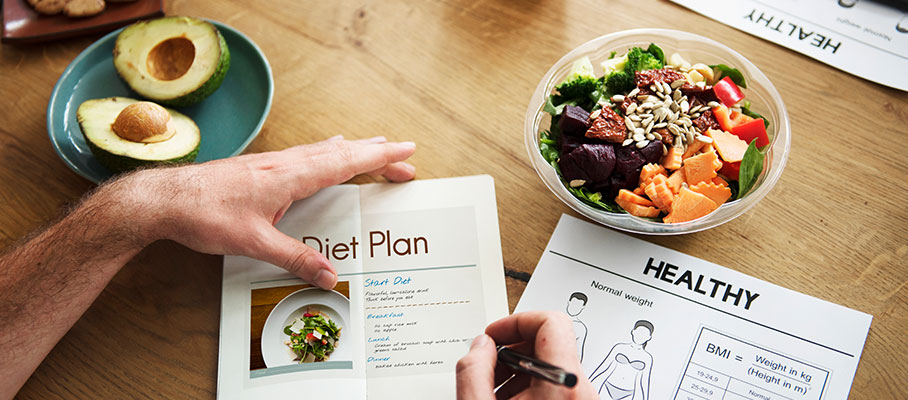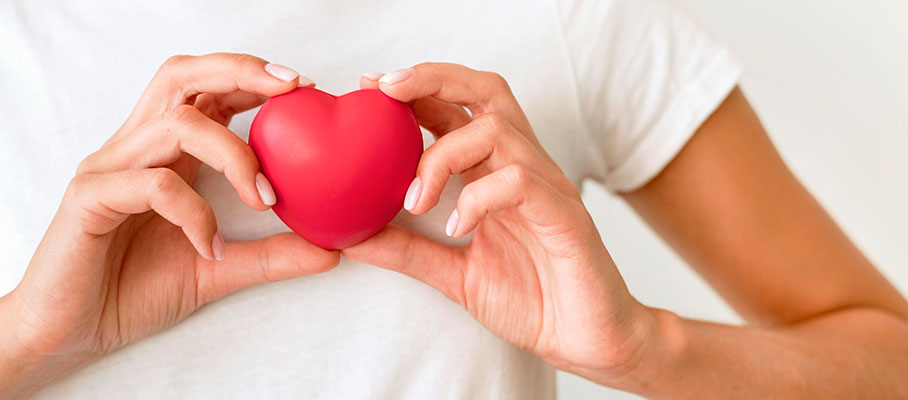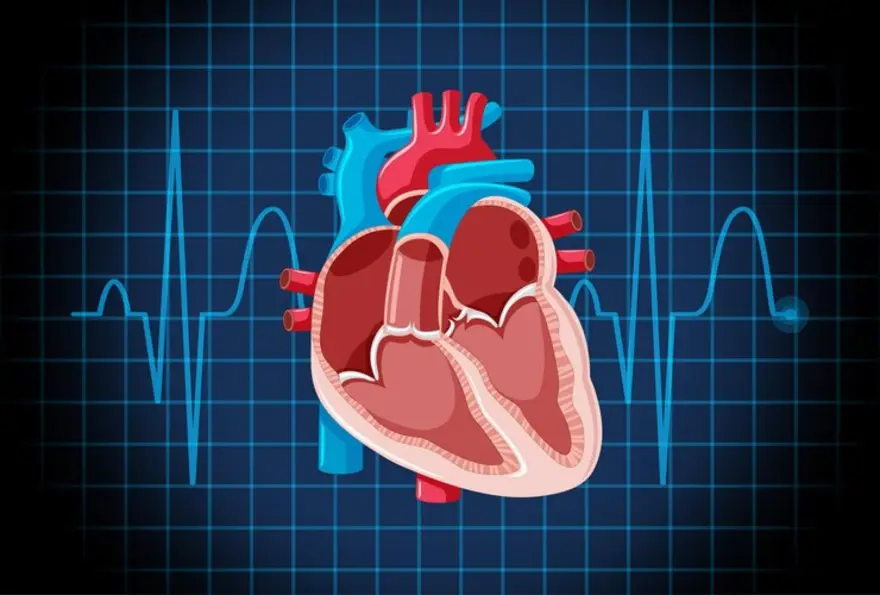Health packages for women
9 Tips to Keep Your Dieting on Track and Make Most of It
Healthy eating and lifestyle can help you lose weight, improve your health and wellness, and prevent risk for diseases. Despite all these benefits, it can be hard to stick to a healthy diet because eating healthy is not always easy. If you’ve been dieting for a few months, or just a few weeks, and are finding it challenging to stay consistent and motivated, you are likely not alone. Staying consistent in a diet is way more difficult than starting a healthy diet plan. If you want to know how to keep your dieting on track, here are a few tips to help you stick to your diet plan this time and make most of it. 1. Find your motivation The first step on the journey is "why". Before you even try to decide to make a change, you must first consider why you want this change. Make a list of your reasons, whether that’s a number on the scale or a special piece of your wardrobe, or fitting into a certain pair of jeans, looking your best for an event or something of bigger impact such as preventing a certain disease, improving your self-confidence, living longer and keeping up with grandchildren. Once you've found your motivation, then just hold on to it. Refer to this list when you feel you need a reminder. Thinking about your motivation can help you stay on track.Take care of your health numbers while dieting. Book a test here. 2. Learn important skills Before making healthy changes in your eating habits, you should learn few important skills, such as how to keep yourself focused and motivated every day, how to curb your food cravings, and how to get yourself back on track immediately after a cheat diet. 3. Set realistic goals Always set small, realistic, and achievable goals as goals that are too big and unreal feel too far away to achieve. If you set your goals too high, your plan may backfire. People who expect to lose weight too quickly are more likely to get discouraged and drop out of a healthy diet and weight loss program. Small goals can help keep you going strong because being close to reaching an end target can help you hold out for a little longer. 4. Listen to your body needs Try to understand your body’s true needs. Keeping in tune with your body’s hunger and satiety signals is important for weight loss. Teach yourself the difference between hunger and craving, and eat only when you’re hungry. Next time you feel like eating, pause for a moment and ask yourself whether your body really needs an energy boost or you’re just trying to cure your boredom. Always respect your body and treat it with dignity. Learn to honor your dislikes. If you've tried a specific food several times and don't like it, don't eat it in compulsion. We are fortunate enough to have plenty of food options available to choose from. Eat happily and choose healthy food options. Sure you are taking enough nutrients in diet? Check your vitamins levels here. 5. Aim for consistency, not perfection It’s essential to keep in mind that it’s not always about perfection as much as it is about consistency. And aiming for perfection could end up disappointing you more than it helps. You cannot change your diet overnight and then become perfect with every food choice. Don’t feel like you must avoid any temptation or unplanned cheat meals. Eat in a very healthy way but allow yourself to enjoy some of your favorite foods every once in a while, in moderation. And it’s ok to indulge a little, every now and then. It might even help your progress. 6. Plan your meals ahead People often are not prepared to deal with their temptations before they are in front of them. A pre-planned strategy could increase your chance of success. One of the best ways to keep yourself on track is to plan your daily meal in advance so that you have healthy options on hand if you get hungry. Preparing your meals ahead of time can really help you to stay on course. If you don't cook, then you should have some healthy ready-to-eat snacks. Chances of eating unhealthy food increase when you are hungry and don't have anything healthy to eat. So, keep unhealthy foods out of the house or out of sight. 7. Do eat less but more frequently The best and simple mantra to lose weight is eating fewer calories than you burn. But eating fewer calories doesn’t mean that you have to starve yourself, starving would only slow down the metabolic processes of the body and would harm you and affect you psychologically. Dividing your daily calories into small frequent meals will help you control your appetite and weight. Eating small meals more frequently will fulfill your satiety levels. 8. Make your plate more colorful The best way to get all the essential nutrients, vitamins, and minerals is to include fruits and veggies that make up all the colors of the rainbow. These nutrient-rich foods are high in fiber and water and will give you a feeling of fullness and you won’t feel hungry. 9. Sip slow and more frequently Sipping water all through the day will make you feel fuller and satisfied and you will not feel the need to eat as much. You will have fewer cravings and this will keep you from over-eating. People sometimes confuse thirst with hunger and end up eating unnecessary extra calories. At times when you feel hungry, it could be a sign of thirst. So always sip on some water first to see if the hunger persists. Dehydration can disturb electrolyte levels in your body. Check electrolytes with a quick test. Diet and exercise go together Eating a healthy diet and exercising at the same time increases your chances of success. You will get the results much faster by eating healthy and exercising regularly. Track your food intake and measure your exercise progress to stay motivated and keep going. It may help you stick to a healthy diet and leads to greater weight loss. Rectifying your habits and improving your diet is not easy. However, these tips can help you stay on right track. But they don't include everything. Each dieter is different; you have to find out what works best for you in the long run.
Doctor’s Diary: How to Do a Breast Self-Exam for Breast Cancer?
In 2020, there were 2.3 million women diagnosed with breast cancer and 685,000 deaths worldwide. What is more worrisome is that the incidence is alarmingly increasing globally. After skin cancer, breast cancer has been cited as the most common cancer diagnosed in women across the world. Breast cancer can occur in both men and women, but it's far more common in women. Women are better multitaskers than men, say studies. However, “the multitasker” needs to take care of her health too. Book a TruHealth Package today- specially designed for women. Breast cancer awareness: The need of the hour Breast cancer can begin in different parts of the breast. A breast is made up of three main parts: lobules, ducts, and connective tissue. The lobules are the glands that produce milk. The ducts are tubes that carry milk to the nipple. The connective tissue (which consists of fibrous and fatty tissue) surrounds and holds everything together. Most breast cancers begin in the ducts or lobules. Breast cancer can spread outside the breast through blood vessels and lymph vessels. When breast cancer spreads to other parts of the body, it is said to have metastasized. Breast cancer symptoms Though the symptoms can vary to some extent from person to person, and not all women experience all the symptoms, the most common symptoms of breast cancer include: Skin changes, such as swelling, redness, or other visible differences in one or both breasts A lump or an increase in size or change in shape of the breast(s) Discharge other than breast milk from nipples Pain or ulceration in/on any part of the breast along with lumps or nodes felt on orinside of the breast A study has reported that women aging above 40 with high cholesterol were 45% less likely to develop breast cancer than those without high cholesterol. Track your cholesterol levels from time to time. What can you do to keep yourself safe from breast cancer? A breast self-exam is a simple check-up which women can do at home to look for changes or problems in their breast. This method requires a woman to look at herself and feel each breast for possible lumps, distortions or swelling. With medical awareness being what it is today, many women around the world feel that doing this is important for their health. When to do a breast self-exam? The best time to do a breast self-exam is about 3 to 5 days after your period starts as breasts are not as tender or lumpy at this time of your monthly cycle. If you are pregnant, never had a period, no longer have periods or your period cycle is irregular, choose a specific day each month to perform your self-check. After menopause, try to do this on the same day every month. To prepare for your breast self-test, you can ask your doctor for a demonstration or seek support following the below given steps. Steps to be followed while doing a breast self-examination Step 1 Undress from the waist up and stand straight with your hands on your waist in front of a large mirror in a well lighted room. Observe your breasts; they might not be equal in size or shape and that’s perfectly okay. For most women that’s the case. Take your time and look for any changes in shape, size or position, or any change in skin around it. Check if there is any puckering, dimpling, sores or discoloration. The first time you do this, you might not notice anything but with regular examination you will soon know if there are any changes. If you notice any change, bulging of the skin, visible distortion or swelling, you should bring it to the notice of your doctor. Check your nipples, examine them carefully for any sores, peeling or change in their direction- a nipple that has changed position or has redness, rash or swelling. Strep 2 Raise your arms high and look for the same changes in the mirror. See if there is any sign of fluid coming out of any nipple, it can be watery, milky or yellowish fluid or even blood. Step 3 Lie down on a bed and then touch your left breast with your right hand and vice versa. With the fingertip pads of your hand check your breast using a firm smooth circular motion. Examine the entire breast from top to bottom, side to side- from your collar bone to the top of your abdomen, from your armpit to your cleavage. Follow a pattern so as to cover the whole breast area. Start from the nipple, moving in larger and larger circles until you reach the outer edge of the breast. Or as more women prefer, you can also move your finger pads up and down vertically, in rows like while you are mowing a lawn. Be sure to check all the tissues from the front to the back of your breast. Step 4 Now feel your breasts while standing or sitting. You can even do this while your skin is wet and slippery in the shower. It’s a fact that many women prefer doing it in the shower. Cover your entire breast, using the same movements described in the previous step. When you are self-examining yourself, do not panic if you feel a lump in your breast or other breast changes. There can be a number of causes behind this. It might be due to hormonal changes, a benign breast condition or an injury. On first self-examination many women might find lumps or lumpy areas in their breast but these are common amongst most women and they are not all cancerous. Moreover, many times, changes and lumps disappear automatically over a period of time. But if it persists for a long duration it’s better to consult a doctor and clear any doubts. The more you examine your breasts the more you learn about them And the easier it becomes for you to find any changes in them. Breast awareness is sometimes considered as an informal alternative to breast self-examination. Form a habit of doing a self-examination once a month so that you become familiar with how your breasts normally feel and look. Your goal is to get used to the feel of your breasts which will help you to detect any changes in them over a period of time. There are many conditions that can cause changes in your breast, cancer alone might not be the reason. But if you become familiar with your breast type, then it significantly increases the chances of discovering any lump formation or changes which might be the first sign of breast cancer. Breast Cancer screening It is believed that regularly examining your breasts on your own can be an important way to detect cancer early and get proper treatment. But at the same time one should not depend only on self-exam to rule out cancer. No single test can detect all breast cancer early but breast cancer organisations believe that performing a breast self-exam along with other screening methods can increase the odds of early detection. Regular physical examination by a doctor, mammography and if necessary ultrasound or MRI; all or any might be needed. Apart from breast self-examination, your doctor might do a breast exam and refer to certain imaging tests to learn more about your breast. Mammogram. This detailed X-ray gives doctors a better view of lumps and other problems. Magnetic resonance imaging (MRI). This body scan helps create detailed images of the insides of your breasts. Biopsy. For this test, the doctor removes tissue or fluid from your breast and looks at it under a microscope to check for cancer cells and, if they’re there, learn which type they are. Common procedures include: Fine-needle aspiration Core-needle biopsy Surgical (open) biopsy Lymph node biopsy Image-guided biopsy BottomlineBreast self-exam is the most convenient no-cost tool that one can use regularly anytime and at any age. It is recommended that all women who are at an average risk or have a family history of cancer, perform breast self-exam as part of their overall breast cancer screening strategy.
4 Heart Related Blood Tests for Heart Disease: Assess your Heart Health
Are you aware that your heart, the organ which you usually and casually blame for your unwarranted actions, actually doesn't control your emotions? It, in fact, allows pumping of blood, oxygen, and nutrients throughout your body. It beats over 100,000 times per day and pumps about 1.5 gallons of blood every minute. It keeps itself superactive so that you can keep going. But are you taking enough care of your heart health? Heart disease has become one among the emerging health issues in developing India. As per the WHO, more than four out of five heart disease deaths are due to heart attacks and strokes, and one third of these deaths occur prematurely in people below 70 years of age. Don’t let your sedentary lifestyle invite health problems for you. Keep track of your health parameters through our TruHealth Health Package. Keep Abreast of Emerging Heart Issues with Health Tests Smoking, high blood pressure, high cholesterol and diabetes are some of the common risk factors for developing heart conditions. While your doctor is the best guide to help you identify your risk of heart disease, it is important to know that some heart related blood tests hold a lot of importance to diagnose and manage heart conditions. Top Heart Blood Tests List for Diagnosing Heart Disease 1. Lipid profile test: Also called cholesterol test, this test measures the levels of fats in your blood and can point out towards your risk of having a heart attack, stroke or other heart disease. This test typically includes measurements of various other numbers: Total cholesterol: This refers to the amount of cholesterol in your blood. An increased level of total cholesterol increases your risk of heart disease. In general, your total cholesterol should be under 200 milligrams per deciliter (mg/dL) or 5.2 millimoles per liter (mmol/L). High-density lipoprotein (HDL) cholesterol: Also called the "good" cholesterol, it helps keep arteries open and your blood to flow more freely. Low-density lipoprotein (LDL) cholesterol: Also called the "bad" cholesterol, too much LDL cholesterol in your blood can lead to plaque deposition in your blood vessels, and results in reduced blood flow. These plaque build up may rupture and cause major heart and blood vessel problems. Triglycerides: These are another type of fat in the blood, high levels of which can raise your risk of heart disease. Your triglyceride level should be less than 150 mg/dL (1.7 mmol/L). For your reference: Total cholesterol = HDL cholesterol + LDL cholesterol + 20% of Triglycerides level 2. High-sensitivity C-reactive protein test (hs CRP test) C-reactive protein (CRP) is a protein which is produced by your liver as part of your body's response to inflammation that may occur due to an injury or infection. The hs-CRP test can spot lower levels of C-reactive protein (CRP) in your blood. A raised hs-CRP test values indicate a higher risk of heart attack, stroke and cardiovascular disease. This blood test has a great significance in diagnosing heart conditions as it can help determine your risk of heart disease before you have symptoms. An hs-CRP level above 2.0 mg/L is considered to indicate an increased risk of heart disease. However, CRP levels can be temporarily increased by many other situations other than a heart disease, like a viral infection. Hence, some experts may suggest doing the test twice, two weeks apart. Remember, only looking at hs-CRP levels may not be enough to arrive at something definite. Your doctor can ask for other health tests as well, and combine your hs-CRP test and other blood test results with your risk factors to get an overall sense of your heart health. 3. Natriuretic peptides test Brain natriuretic peptide is a protein that your heart and blood vessels make to help your body eliminate fluids, relax blood vessels and excrete sodium into your urine. When your heart gets damaged, levels of BNP entering your blood increases. Different people can have different values for normal BNP levels since it can vary based on the age, gender, and being overweight. Need help to detect, diagnose, and evaluate the severity of congestive heart failure (CHF)? Book a NT-Pro BNP Serum test that measures the levels of BNP or NT-pro BNP in your blood. 4. Troponin (T) Test for Heart Attack Troponin (or cardiac troponin) is a type of protein found in your heart muscles. It isn't normally found in the blood and is released into the blood when heart muscles become damaged. A troponin test looks for the level of troponin in your blood. As more and more heart muscle gets damaged, greater amounts of troponin are released in the blood. Two types of cardiac troponin T (cTnT) and I (cTnI) are used as cardiac profile test to identify heart injury or damage. A high level of troponin in the blood may indicate you are having or recently had a heart attack. Some studies have found that troponin I is more specific and a better cardiac marker than troponin T blood test for heart attack. Remember that one heart blood test alone may not determine your overall risk of heart disease. If you think your lifestyle or family history can put you at risk of developing heart disease at an early age, get in touch with a doctor, book yourself blood test for heart blockage and heart Disease as advised, and improve your lifestyle habits.
Less Known Facts About Stress and Top 3 Stress Management Tips
Stress is perhaps the most rampant of all the health issues young India is currently struggling with! Be it stress of office work, stress of personal relationships, stress of a sick family member, stress of job security, or stress of an impending assignment- it is omnipresent.Though you might know how being stressed out feels, there can be a different way of looking at bad things closely and know some evidence-based facts around it. Here we are letting you know some less known facts about stress and also apprise on the top 3 stress management techniques that actually work for real people like you and us. Stressful situations are likely to impact your overall well-being. Stay one step ahead of your health parameters through our especially curated lab test packages. Book TruHealth Package here. Lesser known, interesting facts about stress 1. Stress is a hormonal response from the body Stress causes a part of your brain, called hypothalamus, to send signals throughout your nervous system and to your kidneys. As a result, your kidneys release stress hormones including adrenaline and cortisol. These hormones are responsible for giving you the negative health effects which stress is blamed for. 2. Women appear more prone to stress than men Women have a higher risk of experiencing more physical signs of stress compared to their men. That said, don’t interpret that men are not likely to experience stress. Instead, men are more likely to “man-up”, not vent out, and not exhibit any signs despite the chronic stress eating them away from inside.Gift a comprehensive health package and help “the multitasker” of your home stay fit and strong. Book TruHealth SmartWoman package here. 3. Stress can make you feel hot, jittery, and sweaty Stress results in a rise in blood pressure, which causes you to feel hotter, just like you get hot in situations where you’re nervous before giving an important presentation. Now, to dissipate that excessive body heat, you may experience sweating, usually seen on your forehead, armpits, and groin area. Also, your fingers may shake, and you may feel off-balance. Some people can also feel dizzy. 4. Digestive problems with stress are real Stress can make your digestive system go awry, leading to diarrhea or constipation, stomach pain, and excessive urination. It may cause you to feel nauseated. 5. Stress can cause oversleepiness While stress is a common offender related to sleeplessness (insomnia), it can also cause you to oversleep. This daytime sleepiness may develop from the chronic exhaustion from being stressed. 6. Your skin may suffer due to stress Acne breakouts are quite common with stress. While some people may get pimples, others might have itchy rashes. The skin symptoms result due to the underlying inflammatory response stemming from stress. 7. Stress may adversely affect your libido Numerous reports have found that people reported a lack of desire to get intimate when they were anxious or stressed out. In some, orgasm can also be affected. Both men and women can test their hormone levels to understand how well the feelings are flowing. 8. You may gain weight due to chronic stress Continuously nagged by that neighbor who keeps on asking, “Oh ji, Kamjor ho rahe ho, kya chinta ho gayi hai!”? But actually, stress results in excessive cortisol released from the kidneys that can further lead to fat accumulation. In addition, stress-related emotional eating, such as eating junk food or binge eating, may also cause you to gain those extra kilos. Feeling overwhelmed and stressed out? 3 (Yes, Only 3) Stress management techniques to swear by Tip #1: Practice stress relievers like breathing exercises and meditation Okay, we hear you! They can’t help solve the grim circumstances that have triggered your stress, but they can certainly support you to move into a positive frame of mind where you can think clearly and better handle the situation. Meditation can calm you down quickly, returning your body to normal. Tip #2: Invest in a genuine social circle Not all relationships are built equal. You may have a million and one friends on any social media platform, but still not have that one person whom you can reach out to when feeling stressed. Build real relationships that can help you celebrate during your best times and support you through your worst. Focus on strengthening your relationships even from a safe distance. Get over a call and connect over video conferencing. Also, let go of those relationships that drain you. Separate yourself from the dramatic scenarios and stress of meaningless relationships. Tip #3: Organize, Organize, Organize It is a science-backed fact that decluttering a physical space may help declutter your thoughts. Clear and organize those jam-packed drawers and closet. In fact, staying in a cluttered space may also be causing you more stress than you realize. It decreases productivity and robs you of energy. Make a dedicated effort to get more organized. Whether it's putting things into storage, or donating what you no longer need, plan to cull the clutter. The final word from us to you is not around trying to avoid stress. Instead, learn the coping mechanisms to manage stress in a better way.
 Home Visit
Home Visit Upload
Upload


















 WhatsApp
WhatsApp